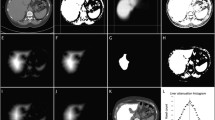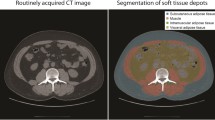Abstract
Quantification of fat and muscle on clinically acquired computed tomography (CT) scans is critical for determination of body composition, a key component of health. Manual tracing has been regarded as the gold standard method of body segmentation; however, manual tracing is time-consuming. Many semi-automated/automated algorithms have been proposed to avoid the manual efforts. Previous efforts largely focused on segmenting two-dimensional cross-sectional images (e.g., at L3/T4 vertebra locations) rather than on the whole-body volume. In this paper, we propose a fully automated three-dimensional (3D) body composition estimation framework for segmenting the muscle and fat from abdominal CT scans. The 3D whole body segmentations are reconstructed from a slice-wise multi-atlas label fusion (MALF) based framework. First, we use a low-dimensional atlas representation to estimate each class for each axial slice. Second, the abdominal wall and psoas muscle are segmented by combining MALF with active shape models and deformable models. Third, skeletal muscle, visceral adipose tissue (VAT) and subcutaneous adipose tissue (SAT) are measured to assess the areas of muscle and fat tissue. The proposed method was compared to manual segmentation and demonstrated high accuracy. Then, we evaluated the approach on 40 CT scans comparing the new method to a prior atlas-based segmentation method and achieved 0.854, 0.740, 0.887 and 0.933 on Dice similarity index for the skeletal muscle, psoas muscle, VAT and SAT, respectively. Compared with the baseline, our method showed significantly (\(p\,{<}\,0.001\)) higher accuracy on skeletal muscle, VAT and SAT estimation.
Access this chapter
Tax calculation will be finalised at checkout
Purchases are for personal use only
Similar content being viewed by others
References
Yip, C., Dinkel, C., Mahajan, A., Siddique, M., Cook, G., Goh, V.: Imaging body composition in cancer patients: visceral obesity, sarcopenia and sarcopenic obesity may impact on clinical outcome. Insights Imaging 6(4), 489–497 (2015)
Lee, S., Gallagher, D.: Assessment methods in human body composition. Curr. Opin. Clin. Nutr. Metab. Care 11(5), 566–572 (2008)
Popuri, K., Cobzas, D., Esfandiari, N., Baracos, V., Jagersand, M.: Body composition assessment in axial CT images using FEM-based automatic segmentation of skeletal muscle. IEEE Trans. Med. Imaging 35(2), 512–520 (2016)
Idoate, F., Cadore, E., Casas-Herrero, A., Zambom-Ferraresi, F., Marcellán, T., de Gordoa, A., Rodriguez-Mañas, L., Bastarrika, G., Marques, M., Martínez-Velilla, N.: Adipose tissue compartments, muscle mass, muscle fat infiltration, and coronary calcium in institutionalized frail nonagenarians. Eur. Radiol. 25(7), 2163–2175 (2015)
Yao, J., Sussman, D., Summers, R.: Fully automated adipose tissue measurement on abdominal CT. In: Weaver, J., Molthen, R. (eds.) Proceedings of the SPIE Medical Imaging 2011: Biomedical Applications in Molecular, Structural, and Functional Imaging, vol. 7965, p. 79651Z. SPIE (2011)
Inoue, T., Kitamura, Y., Li, Y., Ito, W., Ishikawa, H.: Psoas major muscle segmentation using higher-order shape prior. In: Menze, B., Langs, G., Montillo, A., Kelm, M., Müller, H., Zhang, S., Cai, W., Metaxas, D. (eds.) MCV 2015. LNCS, vol. 9601, pp. 116–124. Springer, Cham (2016). https://doi.org/10.1007/978-3-319-42016-5_11
Chung, H., Cobzas, D., Birdsell, L., Lieffers, J., Baracos, V.: Automated segmentation of muscle and adipose tissue on CT images for human body composition analysis. In: Miga, M., Wong, K. (eds.) Proceedings of the SPIE Medical Imaging 2009: Visualization, Image-Guided Procedures, and Modeling, vol. 7261, p. 72610K. SPIE (2009)
Zhang, W., Liu, J., Yao, J., Summers, R.: Segmenting the thoracic, abdominal and pelvic musculature on CT scans combining atlas-based model and active contour model. In: Novak, C., Aylward, S. (eds.) Proceedings of the SPIE Medical Imaging 2013: Computer-Aided Diagnosis, vol. 8670, p. 867008. SPIE (2013)
Xu, Z., Conrad, B., Baucom, R., Smith, S., Poulose, B., Landman, B.: Abdomen and spinal cord segmentation with augmented active shape models. J. Med. Imaging 3(3), 036002 (2016)
Modat, M., Ridgway, G., Taylor, Z., Lehmann, M., Barnes, J., Hawkes, D., Fox, N., Ourselin, S.: Fast free-form deformation using graphics processing units. Comput. Methods Programs Biomed. 98(3), 278–284 (2010)
Wang, H., Suh, J., Das, S., Pluta, J., Craige, C., Yushkevich, P.: Multi-atlas segmentation with joint label fusion. IEEE Trans. Pattern Anal. Mach. Intell. 35(3), 611–623 (2013)
Yuan, J., Bae, E., Tai, X.C.: A study on continuous max-flow and min-cut approaches. In: Proceedings of the IEEE Conference on Computer Vision and Pattern Recognition - CVPR 2010, pp. 2217–2224. IEEE (2010)
Yuan, J., Ukwatta, E., Tai, X., Fenster, A., Schnörr, C.: A fast global optimization-based approach to evolving contours with generic shape prior. UCLA Technical Report, pp. 12–38. CAM (2012)
Acknowledgements
This research was supported by NIH 1R03EB012461, NIH 2R01 EB006136, NIH R01EB006193, NIH P30 CA068485, NIH R01 HL 098445 (PI - Carr), and AUR GE Radiology Research Academic Fellowship, and in part using the resources of the Advanced Computing Center for Research and Education (ACCRE) at Vanderbilt University, Nashville, TN. This project was supported in part by VISE/VICTR VR3029 and the National Center for Research Resources, Grant UL1 RR024975-01, and is now at the National Center for Advancing Translational Sciences, Grant 2 UL1 TR000445-06. The content is solely the responsibility of the authors and does not necessarily represent the official views of the NIH. This research was supported in part by the National Natural Science Foundation of China (Grant No. 91630311) and the Fundamental Research Funds for the Central Universities (Grant No. 2017XZZX007-02).
Author information
Authors and Affiliations
Corresponding author
Editor information
Editors and Affiliations
Rights and permissions
Copyright information
© 2018 Springer International Publishing AG
About this paper
Cite this paper
Hu, P. et al. (2018). Automated Characterization of Body Composition and Frailty with Clinically Acquired CT. In: Glocker, B., Yao, J., Vrtovec, T., Frangi, A., Zheng, G. (eds) Computational Methods and Clinical Applications in Musculoskeletal Imaging. MSKI 2017. Lecture Notes in Computer Science(), vol 10734. Springer, Cham. https://doi.org/10.1007/978-3-319-74113-0_3
Download citation
DOI: https://doi.org/10.1007/978-3-319-74113-0_3
Published:
Publisher Name: Springer, Cham
Print ISBN: 978-3-319-74112-3
Online ISBN: 978-3-319-74113-0
eBook Packages: Computer ScienceComputer Science (R0)




